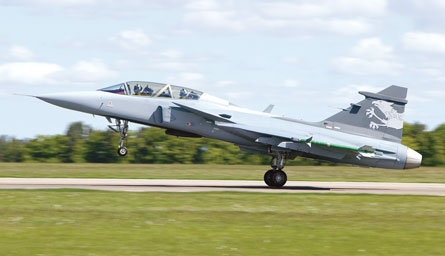Saab's Gripen Demo aircraft, intended as a bridge to the next generation version of the fighter, has completed its third test flight, and is expected to log between 40 and 60 by year-end, as the project builds towards its second phase.
In its Phase I guise the demonstrator incorporates a new landing gear and weapons pylons, plus a General Electric F414G engine. Phase II upgrades will include a new modular avionics system, which Saab says will use layers and partitions to isolate system components and separate flight-critical from mission functions.
Other enhancements will include increased internal fuel capacity and a 1,700 litre (450USgal) external fuel tank, integration of small diameter bombs, enhanced satellite communications and a broadband datalink, an active electronically scanned array radar and missile approach warners.
 |
|---|
Saab's Gripen International marketing arm meanwhile expects to announce "three to four" new customers within the next two years, says sales and marketing senior vice-president Bob Kemp. Three categories of potential customer have been identified: new NATO members seeking to replace ageing Soviet aircraft non-aligned countries looking to migrate from the Dassault Mirage and Sepecat Jaguar and current Northrop F-5, Lockheed Martin F-16 and Boeing F-18 customers planning to renew their fleets.
Kemp acknowledges that this third category of business is the "most difficult" to win, but is hopeful that Malaysia and Switzerland may follow the example of Thailand, which in October 2007 ordered six Gripens to replace some of its F-5Es.
Switzerland has a requirement for up to 33 aircraft to replace its F-5Es from 2012, with responses to its January request for proposals due during July. Flying evaluation will take place later this year, followed by best and final offers in the first quarter of 2009 and a government decision in the third quarter of next year. Boeing has already withdrawn its F/A-18E/F Super Hornet from the competition, and Kemp claims that selection of the rival Dassault Rafale or Eurofighter Typhoon would not fit with Switzerland's mooted budget of around $100 million per aircraft.
Other potential next-generation Gripen customers include Canada, which is expected to issue a request for information next year to replace 70 CF-18s, Denmark and Norway, which will both by year-end decide on how to replace their 48 F-16s, and the Netherlands, which will issue an RFP in early 2009 to replace 85 F-16s.
The putative Norwegian order is widely considered to be crucial to the Gripen NG programme. Although it is a partner in Lockheed's F-35 Joint Strike Fighter project, Oslo has part-financed the Gripen Demo project, and should the nation commit to the Swedish type it is likely that its development will be brought forward.
NATO members Bulgaria, Romania and Slovakia are also looking to replace their RSK MiG-29 fleets, but have yet to allocate budgets, while Croatia has already received RFI responses for a 12-aircraft requirement. An RFP should be released late this year, with the new aircraft to enter service in 2010.
In the "non-aligned" category, Brazil and India are seen as leading sales prospects. Brazil has allocated a budget of over $2 billion for an initial 36 aircraft, and is expected to issue an RFP and award a contract in 2009, ahead of deliveries from 2015. Bidding companies meanwhile have until 4 August to submit offset proposals linked to New Delhi's requirement for 126 multirole aircraft, 108 of which must be locally manufactured.
Kemp says his goal is to sell 400 Gripen C/D fighters over the next 10 years, plus more than 500 next-generation "E/F" examples.
Source: Flight International



















